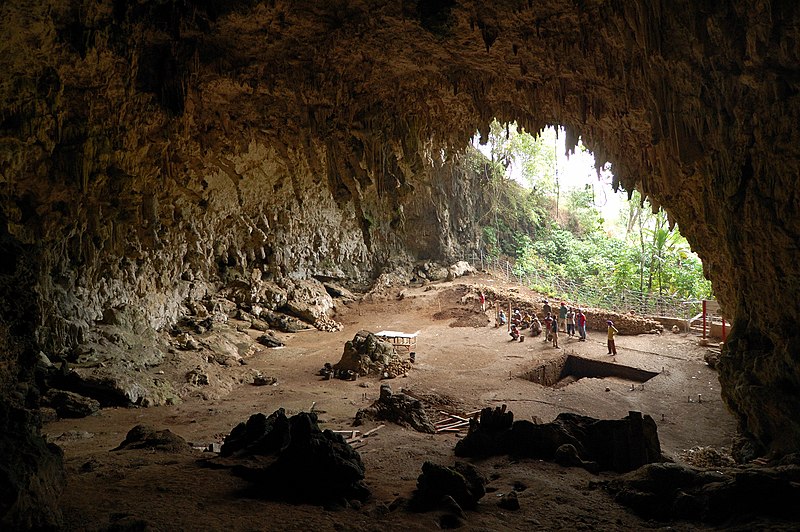.
Anak Ranakah (Child of Ranakah), new lava dome formed in 1987 on the outer flanks of the Poco Leok caldera, Flores, Indonesia: photo by William Rohi (Volcanological Survey of Indonesia)
In the evolution dream a group of us is being conducted through the cave site of the archeological excavation project by a kindly plain older woman, with pleasant face and educated accent, white haired, wearing a long green laboratory coat upon which is affixed a round white badge. She is telling us, patiently, as though sensitive to the shortcomings of our powers of attention, about the ways of these small, slope-chinned, flatfooted cave dwellers: these curious, lightly-furred, hobbit-like little people. As she talks we can see them silently going about the business of their day in the great vaulted space of the cave beyond; a space, hollow as the cranial recess of some vast recumbent creature, to which, with their busy comings and goings, they give the appearance of a natural history museum diorama, but a diorama that that has become animated, a sculptural tableau into which some floating dream forces have breathed life. These little people, she says, might well have made better ancestors.
But, and now her voice seems oddly plaintive, they could never have lasted. There had been a freak genetic mutation, and this part is not yet fully understood. It seems that somehow their brains had actually adapted to altruism...
Someone in the group coughs. Others glance at their watches. Droplets of condensed moisture slowly descend the dark, slick cavern walls. Is it merely the dim lighting in the cave playing tricks that makes her eyes seem to glisten as she begins to speak once more, or are those real tears?
Cave where remains of Homo floresiensis were discovered in 2003, Lian Bua, Flores, Indonesia: photo by Rosino, 2007


This fable, like the two images, feels deep, hollow and sad.
ReplyDeleteHOLY MACKEREL! you've given to me a visual of cave where Stone Girl lived!!!
ReplyDeletewhat DID Breton say?;
"the imaginary is what tends to become real"
It is a dream, a fable... also a picture of the home of some remarkable little people who vanished abruptly and mysteriously from the face of the earth some 17,000 years ago.
ReplyDeleteI say mysteriously, but it's looking more and more like the mystery has a simple solution: Homo floresiensis encountered Homo sapiens.
Thank you for posting a link to the Guardian article. Amazing.
ReplyDeleteTom,
ReplyDeleteThanks for this, and the link to "little people" on Flores, "their day in the great vaulted space of the cave". . . .
Tom, A moving fable, the more astonishing for your link to facts I had not known. Could a race survive brains that adapted to altruism? The world becomes bigger and I become more defined in it when I visit here.
ReplyDeleteHello Marylinn,
ReplyDeleteAnd I must admit I do kind of like these little hobbit people. They were furry and, in my imagination, intelligent and perhaps even, dare I say it, kind... they had long flat feet which must have made ambulation a bit like walking in snowshoes, a high-stepped gait required. Which means they could not propel themselves along very swiftly. But it seems they did manage to compete successfully with some of the serious local contenders -- humongous Stegodons, giant rats, formidable Komodo dragons. They had small brains, but the important bits they did have, and fairly well developed at that: cranial fossil evidence shows that the dorsomedial prefrontal cortex (Brodmann's area 10, as it's called), associated with intelligence and self awareness, was developed at least as fully as the same area in Homo sapiens. They made stone tools and seem to have had certain cultural skills. All might have gone well for them... had not the humans shown up.